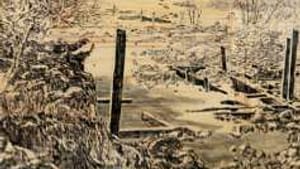Stay in the Loop
BSR publishes on a weekly schedule, with an email newsletter every Wednesday and Thursday morning. There’s no paywall, and subscribing is always free.
A novel unfolding in her mind
Orit Hofshi's "Pharos' at Locks Gallery

The upstairs gallery at Locks is a big, wide-open space. I've seen the scale of the room work for and against exhibits, but Orit Hofshi's "Pharos" is tailor-made for it.
Hofshi is a printmaker on a grand scale, with a freedom of vision and execution that's exhilarating to witness. She's a sabra— a native of Israel born on a kibbutz— which is an important part of her identity. Her ties to Philadelphia are strong as well: She lived here for some years and studied at the Pennsylvania Academy of Fine Arts.
Printmaking, drawing, mark making— Hofshi isn't bothered by fine distinctions, nor by what's behind the curtain and what's in front. Much of the technical pleasure of the exhibit comes from seeing Hofshi so at ease with scale and medium, and ignoring boundaries between techniques of drawing, painting, printing and carving.
Human presence
One striking work, titled Remnant, is a full wall of wood in which the natural grain of the assembled panels vies for attention with a carved, drawn and inked narrative, a naturalistic scene of trees, ground and rocks that suggests a human presence just absent or just about to enter. The vigor of Hofshi's attack on the wood as she shapes it is part of the story; she makes a landscape in which she herself is visibly present.
In Steadfastness, a hand-rubbed print on paper, a building façade is either sinking or barely holding on against a rising of rock or debris. In this sepia-toned piece, as in Remnant, the viewer is at once aware of the physical medium"“ here a standing row of roughly inked planks"“ and the eerie, incomplete story of that vulnerable façade.
A wood panel work, Encirclement, is damp and brooding— a close scene of dark water sprouted with plants and reeds, stuck with odd uprights that suggest human manipulation of the environment.
Smell of decay
A few of the works have a male figure, seemingly a repeat of the same woodcut. In Pharos, a combined ink drawing and print, this male stands on a rough ledge of stone, looking down into a pit, across which stretches a short, shaky bridge. Beyond the bridge is the blankness of paper, or perhaps sky or sea. Facing away from the viewer, the man's hunched stance conveys a wide, if passive, array of emotions, none of them hopeful.
A palpable sense— almost a smell— of ruin and decay rises from many of Hofshi's works here. Still, they don't come across as bleak or post-apocalyptic. Rather they evoke the decay that enables growth: life feeding upon life to create new life. Hofshi appears to be beckoning us into a continuing narrative, a gigantic graphic novel unfolding in her mind and hands.
Hofshi is a printmaker on a grand scale, with a freedom of vision and execution that's exhilarating to witness. She's a sabra— a native of Israel born on a kibbutz— which is an important part of her identity. Her ties to Philadelphia are strong as well: She lived here for some years and studied at the Pennsylvania Academy of Fine Arts.
Printmaking, drawing, mark making— Hofshi isn't bothered by fine distinctions, nor by what's behind the curtain and what's in front. Much of the technical pleasure of the exhibit comes from seeing Hofshi so at ease with scale and medium, and ignoring boundaries between techniques of drawing, painting, printing and carving.
Human presence
One striking work, titled Remnant, is a full wall of wood in which the natural grain of the assembled panels vies for attention with a carved, drawn and inked narrative, a naturalistic scene of trees, ground and rocks that suggests a human presence just absent or just about to enter. The vigor of Hofshi's attack on the wood as she shapes it is part of the story; she makes a landscape in which she herself is visibly present.
In Steadfastness, a hand-rubbed print on paper, a building façade is either sinking or barely holding on against a rising of rock or debris. In this sepia-toned piece, as in Remnant, the viewer is at once aware of the physical medium"“ here a standing row of roughly inked planks"“ and the eerie, incomplete story of that vulnerable façade.
A wood panel work, Encirclement, is damp and brooding— a close scene of dark water sprouted with plants and reeds, stuck with odd uprights that suggest human manipulation of the environment.
Smell of decay
A few of the works have a male figure, seemingly a repeat of the same woodcut. In Pharos, a combined ink drawing and print, this male stands on a rough ledge of stone, looking down into a pit, across which stretches a short, shaky bridge. Beyond the bridge is the blankness of paper, or perhaps sky or sea. Facing away from the viewer, the man's hunched stance conveys a wide, if passive, array of emotions, none of them hopeful.
A palpable sense— almost a smell— of ruin and decay rises from many of Hofshi's works here. Still, they don't come across as bleak or post-apocalyptic. Rather they evoke the decay that enables growth: life feeding upon life to create new life. Hofshi appears to be beckoning us into a continuing narrative, a gigantic graphic novel unfolding in her mind and hands.
What, When, Where
Orit Hofshi: “Pharos.†Through April 13, 2012 at Locks Gallery, 600 Washington Square South. (215) 629-1000 or www.locksgallery.com.
Sign up for our newsletter
All of the week's new articles, all in one place. Sign up for the free weekly BSR newsletters, and don't miss a conversation.

 Marilyn MacGregor
Marilyn MacGregor